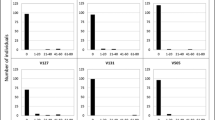Abstract
Bimiracidial infections of Lymnaea ovata with Fasciola hepatica were performed under laboratory conditions to determine the susceptibility of snails from six French populations to trematode infection. In five populations of L. ovata the prevalence of infection in the 1-mm groups ranged between 2.7% and 43.7% at day 35 postexposure; it decreased in the 2-mm snails and was zero in larger groups. In the snails from Thenay (periodically polluted brook) the prevalence of F. hepatica infection decreased from the 1-mm group to the 8-mm group (from 23.9% to 1.0%) and was zero in the 10-mm L. ovata. The total number of cercariae shed per snail was 18.3 in the 1-mm group, increasing to 117 in the 8-mm group. The latter findings could be interpreted as a consequence of periodic pollution in the brook of Thenay; pollution might disrupt the defense system of L. ovata and facilitate the subsequent larval development of F. hepatica.
Similar content being viewed by others
Author information
Authors and Affiliations
Additional information
Received: 15 July 1999 / Accepted: 2 August 1999
Rights and permissions
About this article
Cite this article
Dreyfuss, G., Vignoles, P. & Rondelaud, D. Variability of Fasciola hepatica infection in Lymnaea ovata in relation to snail population and snail age. Parasitol Res 86, 69–73 (2000). https://doi.org/10.1007/s004360050013
Issue Date:
DOI: https://doi.org/10.1007/s004360050013




